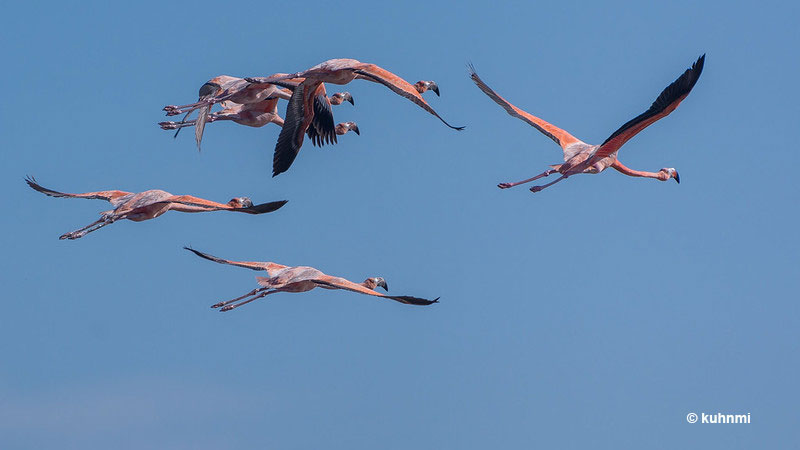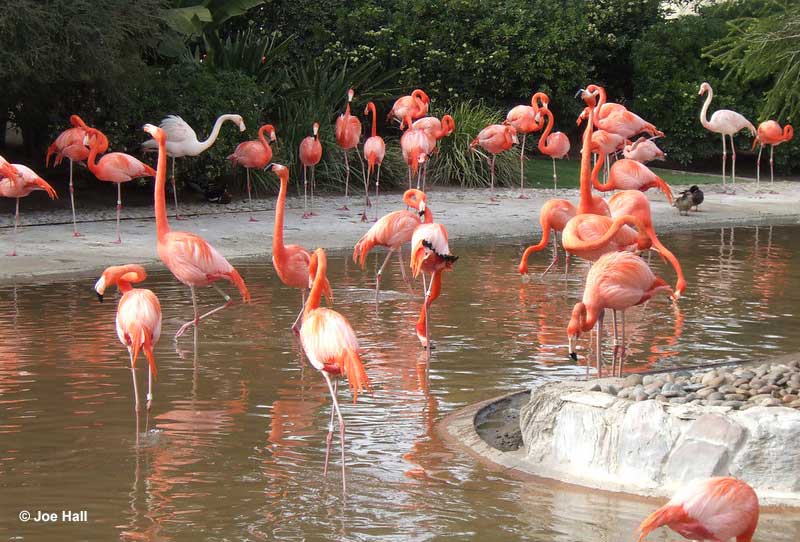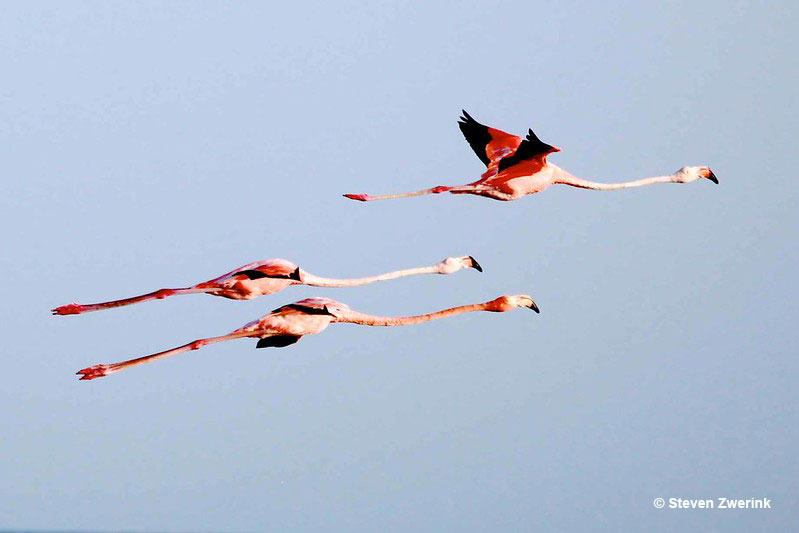
Flamingos are such iconic birds! With their long necks and legs, these iconic pink birds are a definition of elegance.
They love to wade in shallow water where they strut their stuff and show their exotic colors. However, flamingos spend so much time standing around, it’s easy to wonder if they can fly!
See this article to learn the answer to that question and more about flamingos!
On this page
Do All Flamingos Fly?
Flamingos can certainly fly. Although we may be used to seeing flamingos in zoos that have had their wings clipped, in the wild, all flamingo species are capable of flight. In fact, they fly better than a lot of birds, especially ones like quail and other species that can’t fly for long distances.
However, if that’s the case, why do so many folks wonder if flamingos might be flightless? That idea stems from the fact that they are often seen in zoos, and the stately pink birds don’t fly as often as some other birds.

Instead of doing a lot of flying around, flamingos spend most of their time wading and feeding in shallow water. They may need to spend so much time foraging because they eat brine shrimp and other little crustaceans that the birds filter out of the water with their beaks.
Eventually, though, the water where they feed dries up or the flamingos eat most of the shrimp. When that happens, flamingos have no choice but to search for better feeding areas. To find them, the flock takes to the air, soars into the sky, and flies towards other potential feeding sites.
Like other birds, flamingos also fly to escape predators, especially Coyotes and cats.
Flight Patterns
Flamingos are just as elegant in flight as they are when foraging in shallow tropical lakes. However, they can’t just jump into the air.
To take flight, flamingos start by running while they flap their long, broad wings. It doesn’t take long for them to rise into the air.
As they continue to deeply flap their wings, the birds hold their long legs stretched out behind them and extend their elongated necks out in front. In essence, they look a bit like striking pink, flying arrows!
Their flight pattern also looks a bit like that of geese. Like waterfowl, flamingos fly in loose flocks that often form a V formation. Although they can soar, they mostly fly with deep steady flaps.
Read more: Bird facts and statistics that will blow your mind!
Although they might hesitate to fly, once flamingos take to the air, they can stay aloft for hours and for 100s of miles. They also typically fly around 35 miles per hour, but when taking advantage of a tailwind, can fly faster.
These beautiful birds don’t usually go that far, but if they can’t find a suitable feeding area, they will keep moving until they find a good spot. With that in mind, this is why they are occasionally seen far from their usual range.
Do Flamingos Migrate?
Most of the world’s six flamingo species make short migratory movements. The birds move around in search of ideal feeding situations, but most don’t fly for long distances. The exception is the Greater Flamingo of Eurasia and Africa.
Some populations of this species that breed in central Asia do migrate hundreds of miles between their breeding grounds and wintering areas in India and the Middle East.
In Africa, flocks of Lesser Flamingos can also migrate hundreds of miles at night to reach suitable feeding sites. They migrate within Africa, but occasionally, one gets lost and flies north to the Middle East or even Europe.
In North and South America, the American Flamingo also makes some movements within and between Caribbean Islands. Such small flocks of flamingos regularly fly to southern Florida. However, this species doesn’t carry out any regular, long-distance migrations.
Fun Facts About Flamingos & Their Flight
- Hurricanes occasionally bring flamingos far from home. In 2023, as Hurricane Idalia passed through the Yucatan Peninsula, it scooped up several flamingos and brought them north to several states where they don’t usually occur. Birds were seen in many places, including as far away as Wisconsin!
- While most American Flamingos live in the Caribbean, there is a small population that also occurs on the Galapagos Islands. These birds likely became established there after a wandering flock found the islands hundreds or even thousands of years ago.
- Flamingos can fly just as well at very high altitudes in the Andes as they can in hot, tropical lowlands.
- When flying over the ocean, flamingos usually fly much lower than when they fly over land.
- Whether in flight or wading in shallow water, a flock of flamingos is known as a “flamboyance.”
- If flamingos change all of their flight feathers at once, they become flightless for around three weeks.
- In some places, flamingos have to be careful of eagles that prey on them. The large birds of prey can attack flamingos when they are on the ground but can also catch them in flight.
Frequently Asked Questions
At what age do flamingos start flying?
Flamingos start flying at 13 weeks of age.
How come flamingos held in captivity do not fly away?
Flamingos held in captivity do not fly because their wings are clipped or altered in other ways that keep them from flying.
Do flamingos fly for long periods of time?
Yes, flamingos can fly for long periods of time. They can fly several hours.



Veronica Hand
Saturday 18th of November 2023
We used to have a myna bird as a pet he lived many years, was very smart. How come we don't see them for sale any more. Can you still get them?
Patrick O'Donnell
Tuesday 21st of November 2023
@Veronica- I also recall seeing them in pet stores in the past. Nowadays, people buy Mynahs directly from people who breed them. They aren't huge numbers of Mynahs in captivity and they can be fairly expensive to buy.